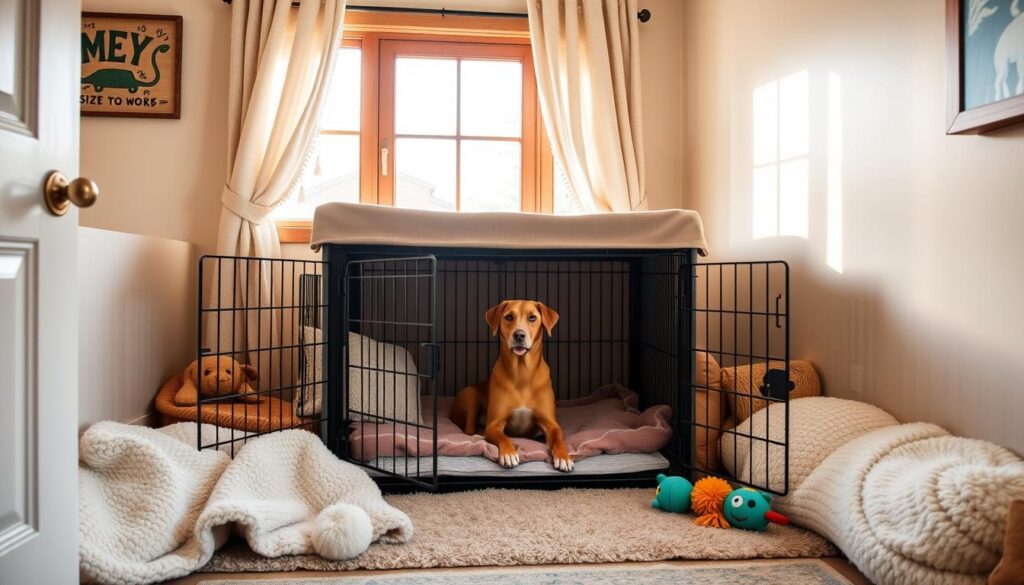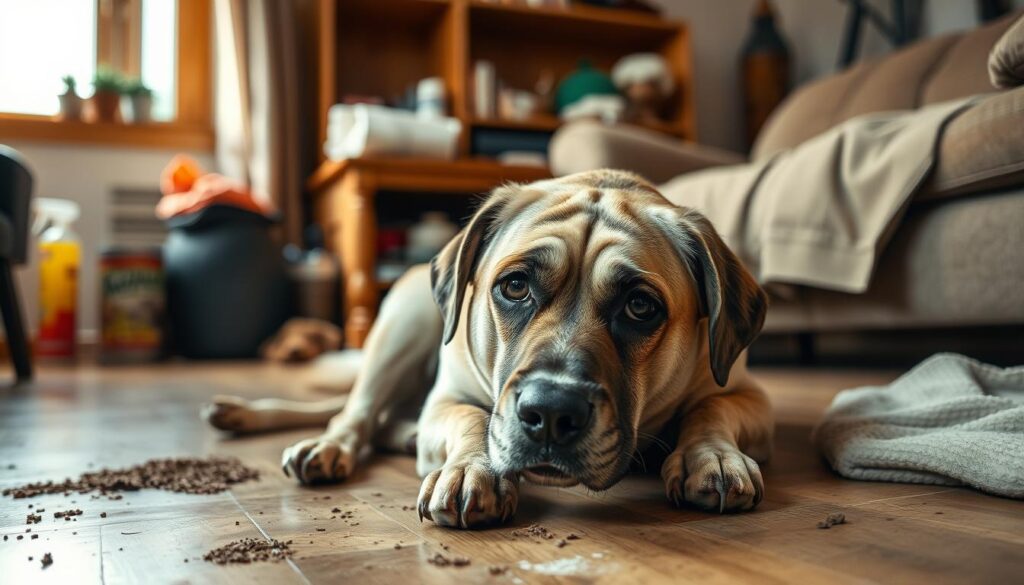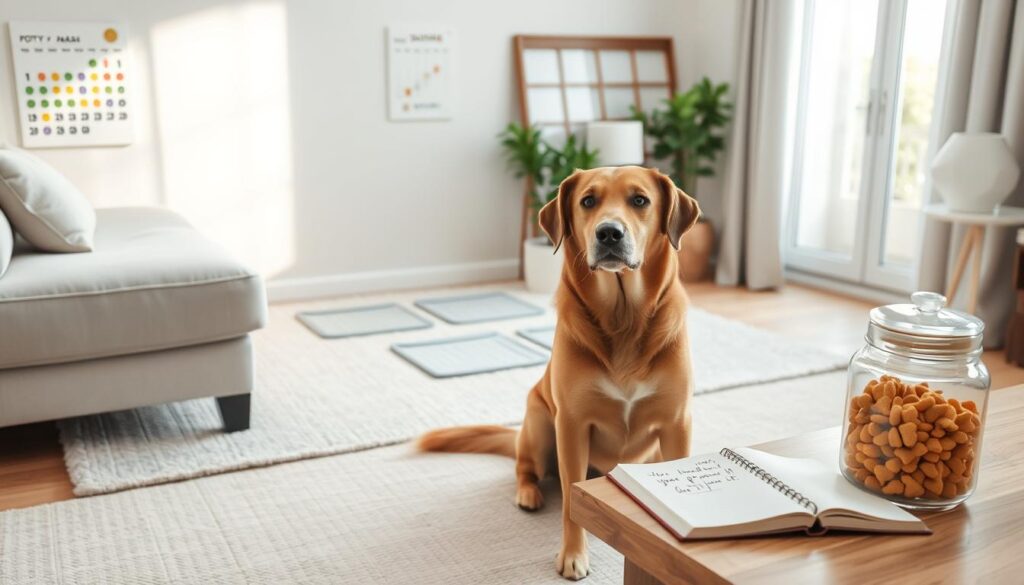How to House Train an Adult Dog | Complete Guide to Success
As a devoted dog owner, I’ve faced the challenges of house training an adult dog. It can seem tough, but with the right steps and patience, even the most stubborn dog can learn. In this guide, I’ll share the strategies I’ve learned from dog training experts.
Key Takeaways
- Adult dogs can typically be house trained in a matter of weeks, while small and senior dogs may take longer.
- Crate training can be an effective method for house training adult dogs, providing a safe space and aiding in potty training.
- Ruling out any underlying medical issues is crucial before starting the training process.
- Positive reinforcement and a consistent daily routine are key to successfully house training an adult dog.
- Proper management of indoor accidents and a focus on setting the dog up for success are essential.
Understanding Adult Dog Potty Training Challenges
Training an adult dog to use the potty might seem hard, but it’s not true that older dogs can’t learn. Adult dogs can often hold their urine longer than puppies. This makes training them easier in some ways. But, there are special challenges when training a grown-up dog.
Common Misconceptions About Training Older Dogs
Many people think older dogs are too old to learn new things. But this isn’t true. With patience, consistency, and positive feedback, older dogs can learn to follow potty routines just like younger dogs.
Medical Considerations Before Starting
Before starting training, it’s important to check for any health problems that might cause accidents. Issues like diabetes, urinary tract infections, and kidney failure can make it hard for dogs to control their bladder. Fixing these health issues first can help the training go better.
Behavioral Factors That Affect Training
Rescued or adopted adult dogs might have emotional barriers to potty training because of past experiences. These dogs need extra patience and understanding. A consistent routine and positive reinforcement can help them overcome these challenges.
Training an adult dog to use the potty is definitely possible. It can really improve their life and yours. With the right approach and considering their health and behavior, even older dogs can learn to go where they should.
Essential Supplies for House Training Success
House training adult dogs needs the right supplies. A key item is a crate training for adult dogs that fits your dog well. It should let them stand, turn, and lie down easily. This crate acts like a cozy den, making your dog feel safe.
A strong leash is also important. It helps you control your dog and keeps their potty routine consistent. Treats are great for rewarding your dog when they go potty where they should. You’ll also need cleaning stuff, like an enzymatic pet cleaner, to clean up messes fast.
If you’re looking for more indoor potty options, BrilliantPad is a good choice. It’s a self-cleaning dog pad that moves and seals waste. This keeps your home smelling fresh, even when you’re not there.
- Properly sized crate
- Sturdy leash
- High-value treats
- Enzymatic pet cleaner
- BrilliantPad self-cleaning dog pad
With these supplies, you’re ready to start crate training for adult dogs and house training tips for adult rescues. Remember, being consistent, patient, and positive is key. These traits will help your dog learn to go potty where they should.
How to House Train an Adult Dog
Housetraining an adult dog can be tough, but it’s doable with the right steps. You need a consistent schedule, positive rewards, and to handle accidents well.
Creating a Consistent Schedule
Being consistent is key when training an adult dog. Set a regular schedule for meals, potty breaks, and crate time. Take your dog out often, especially after eating, sleeping, and playing.
This predictable routine helps your dog know when and where to go potty.
Positive Reinforcement Techniques
Positive rewards are the best way to train an adult dog. Praise and treat your dog every time they go potty in the right spot. This makes them happy to go there.
Managing Accidents Properly
Accidents happen when housetraining. It’s important to stay calm and not punish your dog. If you see them going potty, stop them and take them to the right spot.
Don’t scold or punish. This can make your dog scared and hurt your bond. Clean up accidents with an enzymatic cleaner to remove smells.
With a consistent schedule, positive rewards, and good accident handling, you can house train your adult dog. It takes time, patience, and effort, but it’s worth it.
| Breed | Bladder Capacity | Potty Break Frequency |
|---|---|---|
| Small Breeds | Smaller Bladders | More Frequent Breaks |
| Large Breeds | Larger Bladders | Less Frequent Breaks |
“Patience and consistency are key when house training an adult dog. With the right approach, your furry friend will learn where to go in no time.”
Choosing the Right Crate for Training
Choosing the right crate is key for crate training your adult dog. The crate should let your dog stand, turn, and lie down easily. Look for a crate with a divider to grow with your dog. Remember, the crate should be a positive space, not a place for punishment.
There are many types of dog crates, each with its own benefits:
- Plastic Dog Crates are tough, well-ventilated, and easy to clean, making them great for home and travel.
- Metal Dog Crates are strong and let in air, but they might not look as good.
- Wooden Dog Crates match your home decor well, but they’re heavy, need assembly, and are hard to clean.
- Soft Dog Crates are cheap for small dogs, but cleaning them can be tough if accidents happen.
When picking a crate, add comfy bedding, toys, and water. This makes the crate a cozy spot for your adult dog. Crate training is essential for all dogs. The right crate helps your older dog feel safe and comfortable.

“Crate training is a valuable skill for all dogs to learn, and with the right crate, you can help your older dog feel secure and at ease during this process.”
Setting Up an Effective Training Environment
Setting up the right training area is key for house training adult rescues. You want a space that’s comfy and free from distractions. This helps your dog learn good potty habits. Choose a cozy crate spot to start your dog’s training journey smoothly.
Selecting the Perfect Crate Location
Find a quiet, low-traffic spot for the crate. It should be away from loud noises and distractions. This spot should let you watch your dog easily and take them out when needed. Don’t put the crate in busy or noisy areas.
Making the Space Comfortable
Make the crate a safe and cozy spot for your dog. Add soft bedding like blankets or dog beds. You can also include favorite toys or treats. Using a white noise machine or pheromone diffuser can help keep the atmosphere calm. Always respect your dog’s space in the crate.
Creating a good training environment is the first step to house training your adult rescue. Remember, older dogs need patience and consistency. Be ready to adjust things as your dog learns and grows.
Establishing a Daily Potty Schedule
Starting adult dog toilet training with a daily routine is key. Puppies and older dogs need to go out every hour. A 6-month-old dog might need to go out every 6 hours.
Feeding your dog three times a day until they’re 6-12 months old is important. Then, switch to two meals a day. Take your dog outside 15-20 minutes after meals to help them learn to go outside.
Being consistent is vital when house training an adult dog. Take your dog out in the morning, after meals, before bed, and every 1-2 hours in between. Use leash walks for these breaks to keep them focused and reinforce training.
Use enzymatic cleaners to get rid of urine or feces smells. Dogs are drawn to these smells and might go back to the same spot.
- Develop a consistent feeding schedule to anticipate potty break times.
- Take your dog out 15-20 minutes after meals to encourage outdoor toileting.
- Use leash walks for potty breaks to maintain focus and reinforce training.
- Clean up any accidents with enzymatic cleaners to remove odors and discourage repeat behavior.
- Establish a routine of taking your dog out first thing in the morning, after meals, before bed, and every 1-2 hours in between.
By sticking to a daily potty schedule, you can help your adult dog succeed in toilet training. Consistency and positive reinforcement are essential for good house-training habits.
Using Positive Reinforcement Methods
Positive reinforcement is a great way to house train an adult rescue dog. It rewards good behavior instead of punishing bad ones. This approach helps dogs feel safe and happy. Research shows it works better than punishment-based training.
Reward-Based Training Techniques
To use positive reinforcement well, give high-value treats and praise right after the dog goes in the right spot. This makes them want to do it again. Try different treats and rewards to keep them interested.
Types of Treats and Rewards
- Small, tasty treats like cooked chicken, cheese, or training treats
- Verbal praise and affection, like petting and saying “good boy/girl”
- Interactive toys or playtime as a reward
Don’t punish accidents. It can make the dog feel bad around you. Focus on rewarding good behavior and creating a positive learning environment.
“Positive reinforcement strengthens the bond between dogs and their owners, making them more eager to learn and respond better to training.”
Positive reinforcement can help you house train your adult rescue dog. It also builds a strong, trusting relationship with them.
Managing Indoor Accidents
As dogs get older, they might have trouble with house soiling. This is a common problem known as “house soiling in older dogs.” It can be tough for both the dog and the owner. But, with the right steps, you can manage these accidents well.
Cleaning any messes with enzymatic cleaners is the first step. These cleaners get rid of smells that might draw the dog back. It’s key not to scold the dog for accidents later. This can make them more anxious and worsen the problem.
If you catch the dog in the act, calmly stop them and guide them to the right spot. Rewarding them with treats and praise helps teach them what’s right. Also, using a blacklight can reveal old messes that need extra cleaning.
- Thoroughly clean accidents with enzymatic cleaners to remove odors
- Avoid punishing the dog for accidents found after the fact
- Interrupt and redirect the dog to the appropriate potty spot if caught in the act
- Use a blacklight to find and clean old accident spots
It’s important to find out why the dog is soiling in the house. This could be due to health issues or behavior problems. Regular vet visits can spot health problems. Training and a set potty schedule can also help manage these issues in older dogs.

With a detailed plan, you can make your home safe and comfy for your senior dog. This way, you give them the care and support they need at this time.
Training with Pee Pads and Alternative Methods
Pee pads can be a great tool for house training adult dogs. Disposable pee pads are easy to clean up by throwing them away. Reusable pee pads are better for the environment and can be washed and used again.
Paw Inspired® disposable pee pads use DrySpeed™ Technology to quickly absorb urine. Their reusable puppy pads are also machine-washable, making cleanup easy and promoting reuse.
Transitioning from Indoor to Outdoor Training
The choice between disposable and reusable pee pads depends on the dog’s breed, age, and situation. It’s important to keep a consistent schedule for bathroom breaks, especially for older dogs. They may need more frequent breaks.
Use positive reinforcement like praise and treats to encourage older dogs to use the pee pad. Avoid scolding or punishing them.
Training older dogs to use pee pads takes time, patience, and understanding. It’s important to be dedicated and patient to make the training smooth and comfortable for them.
When moving from pee pads to outdoor training, start by placing the pads near the outdoor spot. This helps the dog learn to associate the outdoor area with the potty spot. Use command words and rewards to help them make the transition.
For some, litter box training can be a good alternative to pee pads. This method trains the dog to use a litter-filled box like a cat. Consistency and positive reinforcement are crucial for a smooth transition.
Patience, consistency, and a positive approach are key to successful house training for adult dogs. Understanding older dogs’ unique needs helps create a comfortable training environment. This sets them up for success.
Monitoring Progress and Adjusting the Training Plan
House training an adult dog needs careful watching and flexibility. Start by keeping a log of when your dog goes to the bathroom. Note both accidents and successes. This helps you see patterns and know what to work on.
As your dog gets better, let them have more freedom in the house. This lets you see how reliable they are and adjust the training plan. If your dog has trouble, change the potty break schedule, where they go, or how you reward them.
House training an adult dog takes time and patience. It can take weeks or months, depending on the dog. Celebrate small wins, like longer times without accidents. Stay consistent, and with time and effort, you can house train your dog.

Every dog is different, so the training might need to change. Watch your dog closely and adjust as needed. This will help you train your dog well.
Troubleshooting Common Training Issues
Housebreaking an adult dog can be tough, but with patience, you can succeed. If your dog is hard to train, try watching them more closely. Keep them away from places where they’ve had accidents.
Watch for signs they need to go outside. This can help a lot.
Dealing with Resistance
Some adult dogs may not want to learn new habits. They might be stubborn. Stay calm and keep training the same way.
Don’t yell or punish them. It only makes things worse. Reward them when they go outside correctly.
Addressing Anxiety-Related Problems
Anxiety can make housebreaking hard for older dogs. Dogs with past traumas might go to the bathroom when stressed. Use calming aids like pheromone diffusers or anxiety wraps.
If your dog’s anxiety doesn’t get better, see a vet. They might suggest medicine to help.
Keep training regular, stay patient, and get help if you need it. This way, you can help your dog learn to go outside when they should.
FAQ
Can adult dogs be house trained?
What should I know before starting house training an adult dog?
What supplies do I need for house training an adult dog?
How do I establish a consistent potty training schedule?
What size crate should I choose for house training?
How should I set up the training environment?
How often should I take my adult dog out for potty breaks?
How can I use positive reinforcement for house training?
What should I do if my adult dog has an accident indoors?
Can I use pee pads or litter boxes for adult dog training?
How do I monitor progress and adjust the training plan?
What if my adult dog is resistant to house training?
Source Links
- 5 Steps to Potty Train an Older Dog, According to a Professional Dog Trainer – https://www.dailypaws.com/dogs-puppies/dog-training/basic/how-to-potty-train-an-older-dog
- Housebreaking Your Dog: Step By Step Process… – Brandon McMillan’s Canine Minded – https://canineminded.com/housebreaking-dog-step-step-process/
- How To Potty Train an Older Dog – https://www.petmd.com/dog/general-health/how-to-potty-train-older-dog
- How to potty train an older dog – https://betterpet.com/how-to-potty-train-an-older-dog/
- Tips for Housetraining Your Puppy – https://www.webmd.com/pets/dogs/house-training-your-puppy
- No title found – https://www.akc.org/expert-advice/health/senior-dog-house-training/
- Indoor Potty Training Guide for Dogs – https://www.brilliantpad.com/blogs/news/indoor-potty-training-guide-for-dogs?srsltid=AfmBOooPVcGwKn0CCbSqUwk7mNAoLp-WGrmLX8e5S31h1fH4WPtHsVl-
- How to Potty Train a Dog: Strategies for Success – https://roguepetscience.com/blogs/dog-training/how-to-potty-train-a-dog
- Potty Training Regression | How to Handle It | Sniffspot – https://www.sniffspot.com/blog/dog-training/what-is-and-how-to-handle-potty-training-regression
- How to Potty Train Older Dogs to Use Fresh Patch – https://www.freshpatch.com/blogs/news/how-to-train-older-dogs-to-use-fresh-patch?srsltid=AfmBOorI1nPIiDLVfkflbWiqUwWXNRTwyBKeeM6jipnLH7eyjoDM2_Lc
- No title found – https://www.akc.org/expert-advice/lifestyle/choose-best-crate-dog/
- How to Crate Train an Older Dog: Comprehensive Guide + Schedule – https://www.sniffspot.com/blog/dog-training/crate-train-an-older-dog
- How to Crate Train an Older Dog: Mastering Late-Life Obedience – https://roguepetscience.com/blogs/dog-training/how-to-crate-train-an-older-dog
- Dog Feeding & Potty Schedule: Vet-Approved Care Guide – Dogster – https://www.dogster.com/dog-training/dog-feeding-and-potty-schedule
- How to House Train a Dog – Methods and Tips | Airtasker AU – https://www.airtasker.com/au/guides/how-to-house-train-dog/
- Effective Use of Positive Reinforcement in Dog Training – https://kastensdogtraining.com/effective-use-of-positive-reinforcement-in-dog-training/
- Housetraining for Puppies and Dogs | VCA Animal Hospitals – https://vcahospitals.com/know-your-pet/house-training-your-puppy
- How to House-Train an Adult Dog: The Umbilical Cord Method (Vet-Approved) – Dogster – https://www.dogster.com/dog-training/umbilical-cord-dog-training
- How To Stop My Dog From Peeing in My House – https://www.brilliantpad.com/blogs/news/how-to-stop-dog-from-peeing-in-house?srsltid=AfmBOorjnReK3bapM1L8CXkY2-oHQHtoByoCJSFLkt4jvGt-e400_QSV
- Here’s how to eliminate your senior dog’s bathroom accidents – https://betterpet.com/old-dog-peeing-inside/
- How to Train a Senior Dog to Use a Pee Pad – https://pawinspired.com/blogs/dogs/how-to-train-a-senior-dog-to-use-a-pee-pad?srsltid=AfmBOopoSEmt_J96035zn2x-q6RtP2dTyslnR5-115rajcssZYIhNsJd
- No title found – https://www.akc.org/expert-advice/training/the-ins-and-outs-of-potty-pad-training/
- Indoor Potty Training Guide for Dogs – https://www.brilliantpad.com/blogs/news/indoor-potty-training-guide-for-dogs?srsltid=AfmBOopl8xGLSDT03UAzcWJxTajdCYf6ThRj7wjtQKcaUKyFMM9PiGhe
- How to House Train a Dog: A Fun and Stress-Free Guide for New Dog Parents – https://getwag.com.au/blogs/dog-talk/how-to-house-train-a-dog?srsltid=AfmBOopHdKp7cAaxvGEKbnOIAV02uYqEZIyS-6LKMTff3OFANjr6E68P
- 10 Common Dog Potty Training Issues (Vet-Verified) – Dogster – https://www.dogster.com/dog-training/dog-potty-training-issues
- House-Training Is Simple, But Not Always Easy – Whole Dog Journal – https://www.whole-dog-journal.com/blog/house-training-is-simple-but-not-always-easy/



